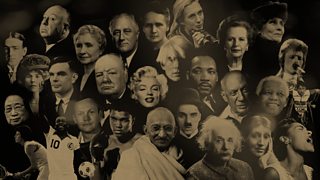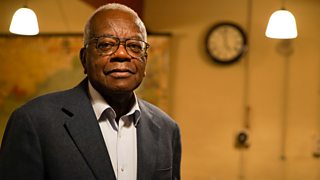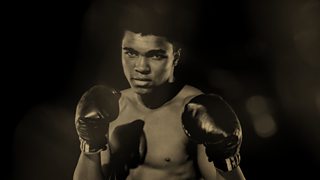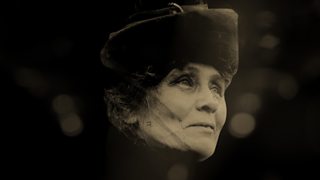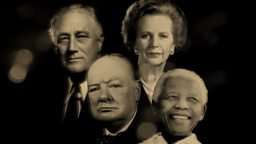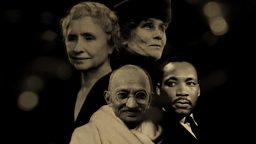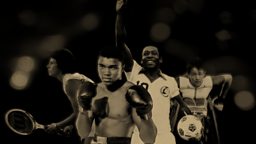Sports Stars
Athletes who changed the world, as well as the sports they dominated
The urge to compete and its expression in sport goes as far back as Ancient Greece and beyond, but the 20th century marked the beginning of a new sporting golden age. Many long standing sports achieved fresh levels of excellence and entertainment.
A combination of technology, professionalism and global coverage meant the sportsmen and women behind these feats became stars, while games like football and events like the Olympics formed a new global culture. Now among the most famous people of their age these outstanding athletes took on new responsibilities. Not only did they achieve unparelleled levels of brilliance in their field, many became role models to those who watched and supported them.
-
![]()
Clare Balding: Sports Stars' Advocate
"A few incredible sports stars in the last century made the most of their moment to change the world around them."
Who do you think is the most impressive?
Muhammad Ali

Lived: 1942-2016
Born: Louisville, Kentucky, US
Known for: As the boxer said himself, he was “the greatest”
Fighting in the ring or for his rights, Muhammad Ali was The Greatest.
Don’t count the days, make the days count.
1. His bouts didn’t end in the ring
Ali was a successful black man living during one of the most turbulent periods for race relations in American history. For some that was a provocation in itself. But Ali was never afraid to speak up, even when his views were controversial – expressing his strong opinions on race, religion and war. His frank stance on politics and society upset the conservative establishment of 1960s and 70s America. He was stripped of titles, banned from his boxing and threatened with prison. Yet his determination, principles and fearlessness in speaking out ensured Ali won through eventually – both in and out of the ring.
2. He said he was “the greatest”; he had a point
Declaring yourself “the greatest” might seem like a fate-tempting, self-aggrandising statement, but Ali fought to live up to the standards he set himself. His impressive fighting style combined with his charismatic personality took boxing to another level. His two epic bouts – the Thrilla in Manila against Joe Frazier and the Rumble in the Jungle versus George Foreman – weren’t just great boxing matches, they became two of 20th century’s great stories.
3. He had to fight to the very end
In 1984 Ali was diagnosed with Parkinson’s Disease but he was determined to carry on making a difference. He made goodwill missions to Afghanistan and North Korea, he brought medical supplies to Cuba and even helped to secure the release of 15 American hostages from Iraq before the 1990 Gulf War; all in spite of his own suffering.
Billie Jean King

Lived: 1943-present
Born: Long Beach, California, US
Known for: Grand Slam-winning tennis player who revolutionised the women’s game
From the courts to the courtrooms, tennis player and champion of women’s rights, Billie Jean King was difficult to defeat.
Champions keep playing until they get it right.
1. She was good at aces… and activism
When King won Wimbledon in 1968 she received £750 – the male winner, Rod Laver received £2000. King wasn’t going to put up with this massive inequality: she fought as hard off court as she did on it to raise the profile and standing of women’s tennis. In 1970 she helped organise a professional women’s tour, while in 1973 her boycott threat forced the US Open to pay equal prize money. Just to underline the point, in that same year she thrashed chauvinistic Bobby Riggs in the Battle of the Sexes match. It was watched by 90 million TV viewers.
2. She believed in volleys… and values
King was publically outed as being gay in 1981. It was a tough time, with a host of companies dropping her from sponsorship deals. But – despite advice from her publicist and lawyer, and not even being comfortable with her own sexuality at the time – she refused to deny being a lesbian. She has since settled into a long-term relationship with former player Ilana Kloss and is now an influential social activist and advocate for gay rights.
3. She was really, really good at tennis
While King’s contribution to women’s and gay rights has been substantial and important, it should be remembered that she was always a dominant force on the tennis court. She won 12 Grand Slam single titles, another 16 doubles and 11 mixed doubles matches, and in 1971 she became the first female athlete to earn over $100,000 in prize money.
±Ê±ð±ôé

Lived: 1940-present
Born: Três Corações, Brazil
Known for: The living, kicking essence of Brazilian football
From poverty to football glory, Pelé brought beauty to the beautiful game and as the first black global football superstar was an inspiration around the world.
The more difficult the victory, the greater the happiness in winning.
1. He had to battle before he’d even got on the pitch
Pelé managed to achieve footballing greatness despite enduring the poverty that blighted large swathes of Brazil’s population. Pelé was so poor that his family couldn’t afford a football: he had to use a stuffed sock. Nonetheless the striker’s natural talent shone through and he was signed by Brazilian team Santos aged 15. A year later he was picked for the national side. A team medical subsequently revealed the squad – Pelé included – was beset by a catalogue of diseases and long-term malnutrition.
2. He was not overawed by the world
The footballer burst onto the world stage in 1958 when Brazil qualified for the World Cup. Just 17, he ran rings around seasoned veterans. The quality of his play and goal tally took him to the first of three World Cup wins with the team in yellow.
3. He brought beauty to the beautiful game
Pelé’s free-flowing style and obvious enthusiasm for the sport filled those who watched him with joy. His success at the highest levels helped coin the term ‘the beautiful game.’ But his legacy is bigger than the cups and medals he won. Pelé proved that anyone, no matter what their background could make it in sport if they had the talent and determination to succeed.
Tanni Grey-Thompson

Lived: 1969-present
Born: Cardiff, Wales, UK
Known for: Paralympian wheelchair racer who won over the world as well as her races
Wheelchair racer Tanni Grey-Thompson won glory for her sport as well as herself, forcing the world to take the Paralympics seriously.
Anything is possible. Part of it is how much you want to do it.
1. She was inspired to win a marathon in a city without kerb drops
At the time Grey-Thompson decided to race in her wheelchair, the British landscape for disabled people was awkward to say the least. No kerb drops, limited lifts and few accessible toilets. Yet when she saw the London Marathon stage its first wheelchair race aged 13, she decided she had to compete. Her eventual success – six wins – and the surrounding publicity no doubt helped to change the very streets she raced on.
2. She set the gold standard
Grey-Thompson’s Paralympic success of 16 medals is made all the more impressive in that she often won multiple medals at the same games. No saving herself for key events; at Barcelona in 1992 she won four gold medals… then did it again at the Sydney Games in 2000. With many of the public unaware of the Paralympics when she started racing, Tanni’s outstanding success has helped raise the profile of the games as a whole. Today we’re prouder than ever of our incredible Paralympians.
3. She’s making politics accessible
As one of the UK’s most decorated Paralympians, Grey-Thompson was recommended for a peerage and she now sits as an independent in the House of Lords. Her sporting success has helped inspire positive changes in our attitude towards disability and she continues to champion disabled people's rights in the corridors of power.
Four sports stars. Four extraordinary achievements. But only one can be the most iconic sports star of the 20th century. The decision is yours.
Watch: Sports Stars of the 20th Century
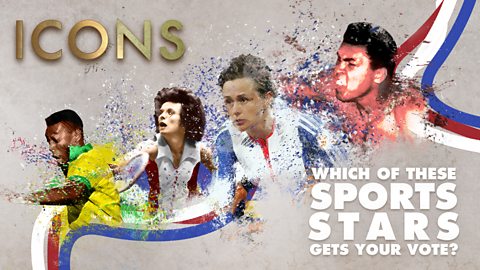
Sports stars of the 20th Century
Four heavyweights, four champions, four role models … Which sports star gets your vote?

